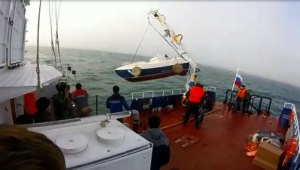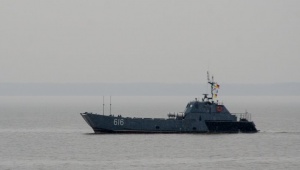Viktor Holodny, staff expert at Morsvyazsputnik, told Mil.Today that San Juan either failed to eject the emergency buoy or it did not surface for some reason. As for him, the buoy might have low battery, but the minimal charge for a single transmission should have been remained, as such batteries retain the charge for five years, and any navy must hold scheduled maintenance.
"Itís hard to analyze anything having no precise technical data from Argentine Navy, but most likely, the buoy has never been ejected. Cospas-Sarsat is a global system. If anyone had received its signal, that message would be definitely sent to Argentine Navy. However, there was nothing like that", said Viktor Holodny.The Cospas-Sarsat signal is received by low-orbit or geostationary satellites, added the expert.
Visibility radius of a low-orbit satellite is about 5,000 km. It flies over the buoy recording its signal. With any compatible radar, this satellite works as a relay and will transmit the buoy signal. If thereís no one to receive the signal, the satellite will keep on flying until it meets the closest radar. Thereís no problem to receive that info: any country getting such distress call would transmit it to Argentine, stressed Viktor Holodny.
A geostationary satellite receives and transmits coordinates only if a buoy has GPS/GLONASS transmitter, the expert told Mil.Today. If thereís no such transmitter, the satellite records the fact of the buoy operation. In this case, dozens of radars will receive the signal data within five minutes.
The expert reminded the accident happened to Estonia ferry equipped with two similar buoys: "When they were picked up and switched on, it turned out that were no satellites to receive their signal. Recalling the tragedy of Kursk, I remind there were no signals either".The previous expert is supported by Alexander Nikitkov, deputy technical director of the Yaroslavl Radio Engineering Plant. Along with the Sevastopol counterpart, the company produces emergency communication aids for marine vessels, including those compatible with Cospas-Sarsat system.
"Such emergency buoy must operate at least 48 hours. With ambient temperature typical for those latitudes, the battery charge must be enough for not less than 24 hours. The signal goes every minute. Positioning error is five nautical miles", the expert told Mil.Today.According to him, the signal failed to pass because of dead or old battery, or the buoy was not ejected at all. If the buoy sent no data, most likely, it did not reach surface: "In this case, the sub is damaged to such extent that prevents both the buoy surfacing and the crew evacuation". The expert emphasized that six days had passed since the last contact with San Juan on Nov 15, and things do not kook very hopeful. Normally, signals come in first hours or days, he added.
Before ceasing to communicate, the Argentine Navyís submarine San Juan reported on some failures with batteries, said the spokesman of Mar del Plata naval base Gabriel Galeazzi on Monday, Nov 20. He did not specify what exactly happened to the batteries of the sub that just had passed overhaul in 2014.
Argentinean diesel electric submarine San Juan got lost off the south coast of the country last Wednesday, November 15, however, the national navy kept that fact unpublished till Friday, Nov 17. There were 44 crewmen onboard the sub.
Mil.Today keeps online broadcasting over the search-and-rescue operation in the Atlantic.

























